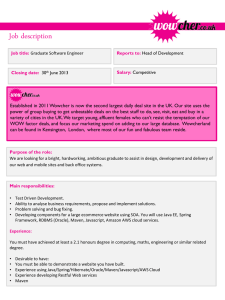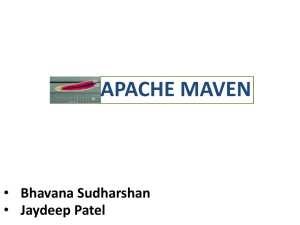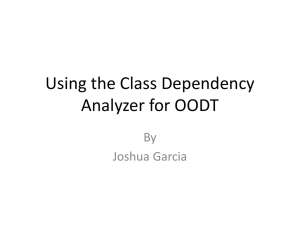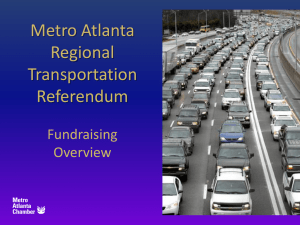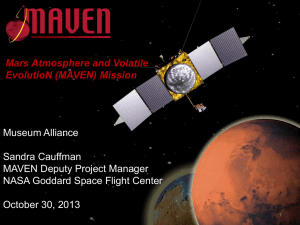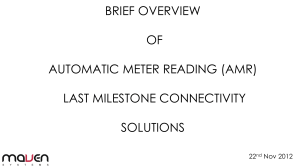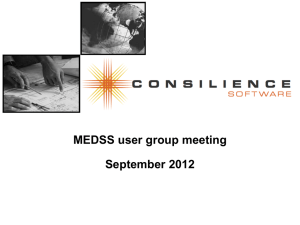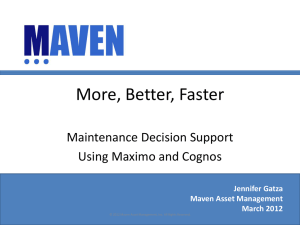IntroductionToMaven
advertisement
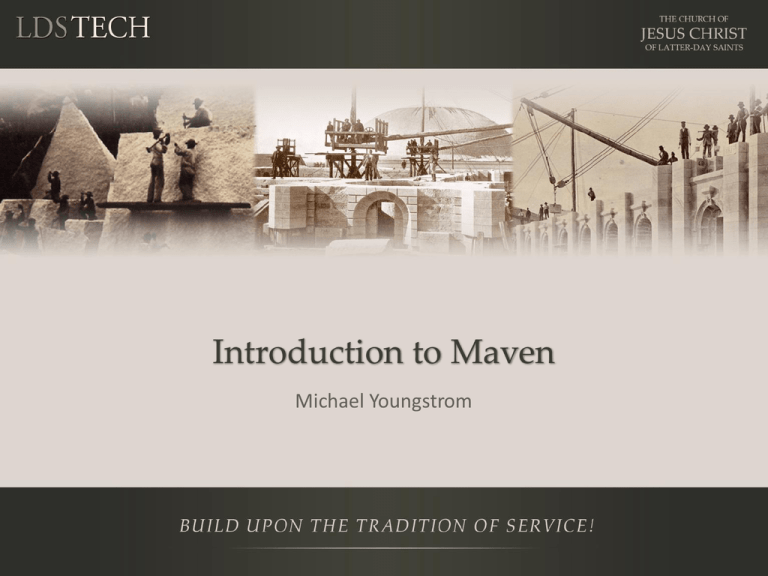
Introduction to Maven
Michael Youngstrom
Notes
• This is a training NOT a presentation
• Please ask questions
• Prerequisites
– Introduction to the Java Stack
– Basic Java and XML skillz
Outline
• Introduce Maven
• Basic Maven Pom File and Project Structure
• Dependencies
Maven Background
• Is a Java build tool
– “project management and comprehension tool”
• An Apache Project
– Mostly sponsored by Sonatype
• History
– Maven 1 (2003)
• Very Ugly
• Used in Stack 1
– Maven 2 (2005)
• Complete rewrite
• Not backwards Compatible
• Used in Stack 2.0,2.1,2.2,3.0
– Maven 3 (2010)
• Same as Maven 2 but more stable
• Used in Stack 2.3, 3.1
Maven Features
•
•
•
•
•
•
Dependency System
Multi-module builds
Consistent project structure
Consistent build model
Plugin oriented
Project generated sites
The Maven Mindset
• All build systems are essentially the same:
–
–
–
–
–
–
Compile Source code
Copy Resource
Compile and Run Tests
Package Project
Deploy Project
Cleanup
• Describe the project and configure the build
– You don’t script a build
– Maven has no concept of a condition
– Plugins are configured
Other Java Build Tools
• Ant (2000)
– Granddaddy of Java Build Tools
– Scripting in XML
– Very flexible
• Ant+Ivy (2004)
– Ant but with Dependency Management
• Gradle (2008)
– Attempt to combine Maven structure with Groovy
Scripting
– Easily extensible
– Immature
Maven Learning Resources
• Maven Homepage
– http://maven.apache.org
• Reference Documentation for Maven
• Reference Documentation for core Plugins
• Sonatype Resources
– http://www.sonatype.com/resource-center.html
• Free Books
• Videos
Lab 1: Learning Resources
https://tech.lds.org/wiki/Introduction_to_Maven#
Lab_1_Learning_Resources
Maven POM
• Stands for Project Object Model
• Describes a project
–
–
–
–
–
–
Name and Version
Artifact Type
Source Code Locations
Dependencies
Plugins
Profiles (Alternate build configurations)
• Uses XML by Default
– Not the way Ant uses XML
Project Name (GAV)
• Maven uniquely identifies a project using:
– groupID: Arbitrary project grouping identifier (no spaces or
colons)
• Usually loosely based on Java package
– artfiactId: Arbitrary name of project (no spaces or colons)
– version: Version of project
• Format {Major}.{Minor}.{Maintanence}
• Add ‘-SNAPSHOT ‘ to identify in development
• GAV Syntax: groupId:artifactId:version
<?xml version="1.0" encoding="UTF-8"?>
<project>
<modelVersion>4.0.0</modelVersion>
<groupId>org.lds.training</groupId>
<artifactId>maven-training</artifactId>
<version>1.0</version>
</project>
Packaging
• Build type identified using the “packaging” element
• Tells Maven how to build the project
• Example packaging types:
– pom, jar, war, ear, custom
– Default is jar
<?xml version="1.0" encoding="UTF-8"?>
<project>
<modelVersion>4.0.0</modelVersion>
<artifactId>maven-training</artifactId>
<groupId>org.lds.training</groupId>
<version>1.0</version>
<packaging>jar</packaging>
</project>
Project Inheritance
• Pom files can inherit configuration
–
–
–
–
–
groupId, version
Project Config
Dependencies
Plugin configuration
Etc.
<?xml version="1.0" encoding="UTF-8"?>
<project>
<parent>
<artifactId>maven-training-parent</artifactId>
<groupId>org.lds.training</groupId>
<version>1.0</version>
</parent>
<modelVersion>4.0.0</modelVersion>
<artifactId>maven-training</artifactId>
<packaging>jar</packaging>
</project>
Multi Module Projects
• Maven has 1st class multi-module support
• Each maven project creates 1 primary artifact
• A parent pom is used to group modules
<project>
...
<packaging>pom</packaging>
<modules>
<module>maven-training</module>
<module>maven-training-web</module>
</modules>
</project>
Maven Conventions
•
•
•
•
•
•
•
•
•
•
Maven is opinionated about project structure
target: Default work directory
src: All project source files go in this directory
src/main: All sources that go into primary artifact
src/test: All sources contributing to testing project
src/main/java: All java source files
src/main/webapp: All web source files
src/main/resources: All non compiled source files
src/test/java: All java test source files
src/test/resources: All non compiled test source files
Maven Build Lifecycle
• A Maven build follow a lifecycle
• Default lifecycle
–
–
–
–
–
–
–
generate-sources/generate-resources
compile
test
package
integration-test (pre and post)
Install
deploy
• There is also a Clean lifecycle
Example Maven Goals
• To invoke a Maven build you set a lifecycle “goal”
• mvn install
– Invokes generate* and compile, test, package, integration-test,
install
• mvn clean
– Invokes just clean
• mvn clean compile
– Clean old builds and execute generate*, compile
• mvn compile install
– Invokes generate*, compile, test, integration-test, package, install
• mvn test clean
– Invokes generate*, compile, test then cleans
Lab 2: Create a Maven Project
https://tech.lds.org/wiki/Introduction_to_Maven#
Lab_2_Create_a_Maven_Project
Maven and Dependencies
• Maven revolutionized Java dependency
management
– No more checking libraries into version control
• Introduced the Maven Repository concept
– Established Maven Central
• Created a module metadata file (POM)
• Introduced concept of transitive dependency
• Often include source and javadoc artifacts
Adding a Dependency
• Dependencies consist of:
– GAV
– Scope: compile, test, provided (default=compile)
– Type: jar, pom, war, ear, zip (default=jar)
<project>
...
<dependencies>
<dependency>
<groupId>javax.servlet</groupId>
<artifactId>servlet-api</artifactId>
<version>2.5</version>
<scope>provided</scope>
</dependency>
</dependencies>
</project>
Maven Repositories
• Dependencies are downloaded from repositories
– Via http
• Downloaded dependencies are cached in a local
repository
– Usually found in ${user.home}/.m2/repository
• Repository follows a simple directory structure
– {groupId}/{artifactId}/{version}/{artifactId}-{version}.jar
– groupId ‘.’ is replaced with ‘/’
• Maven Central is primary community repo
– http://repo1.maven.org/maven2
Proxy Repositories
• Proxy Repositories are useful:
– Organizationally cache artifacts
– Allow organization some control over dependencies
– Combines repositories
• ICS uses the Nexus repository manager
• All artifacts in Nexus go through approval process
– License verified
– Improve organizational reuse
• To request approval create issue in SDS jira project:
– https://jira.ldschurch.org/jira/browse/SDS
Defining a repository
•
•
•
•
Repositories are defined in the pom
Repositories can be inherited from parent
Repositories are keyed by id
Downloading snapshots can be controlled
<project>
...
<repositories>
<repository>
<id>lds-main</id>
<name>LDS Main Repo</name>
<url>http://code.lds.org/nexus/content/groups/main-repo</url>
<snapshots>
<enabled>false</enabled>
</snapshots>
</repository>
</repositories>
</project>
Transitive Dependencies
• Transitive Dependency Definition:
– A dependency that should be included when declaring
project itself is a dependency
• ProjectA depends on ProjectB
• If ProjectC depends on ProjectA then ProjectB is
automatically included
• Only compile and runtime scopes are transitive
• Transitive dependencies are controlled using:
– Exclusions
– Optional declarations
Dependency Exclusions
• Exclusions exclude transitive dependencies
• Dependency consumer solution
<project>
...
<dependencies>
<dependency>
<groupId>org.springframework</groupId>
<artifactId>spring-core</artifactId>
<version>3.0.5.RELEASE</version>
<exclusions>
<exclusion>
<groupId>commons-logging</groupId>
<artifactId>commons-logging</artifactId>
</exclusion>
</exclusions>
</dependency>
</dependencies>
</project>
Optional Dependencies
• Don’t propagate dependency transitively
• Dependency producer solution
• Optional is under used
<project>
...
<dependencies>
<dependency>
<groupId>org.springframework</groupId>
<artifactId>spring-core</artifactId>
<version>3.0.5.RELEASE</version>
<optional>true</optional>
</dependency>
</dependencies>
</project>
Dependency Management
• What do you do when versions collide?
– Allow Maven to manage it?
• Complex and less predictable
– Take control yourself
• Manage the version manually
• In Java you cannot use both versions
<project>
...
<dependencyManagement>
<dependencies>
<dependency>
<groupId>org.springframework</groupId>
<artifactId>spring-core</artifactId>
<version>3.0.5.RELEASE</version>
</dependency>
</dependencies>
</dependencyManagement>
</project>
Using Dependency Management
<project>
...
<dependencyManagement>
<dependencies>
<dependency>
<groupId>org.springframework</groupId>
<artifactId>spring-core</artifactId>
<version>3.0.5.RELEASE</version>
</dependency>
</dependencies>
</dependencyManagement>
<dependencies>
<dependency>
<groupId>org.springframework</groupId>
<artifactId>spring-core</artifactId>
</dependency> <!-- Look ma, no version! -->
</dependencies>
</project>
• Other uses for Dependency Management
– Allowing parent pom to manage versions
– Unify exclusions
Lab 3: Manage Maven Dependencies
https://tech.lds.org/wiki/Introduction_to_Maven#
Lab_3_Manage_Maven_Dependencies
Summary
• Maven is a different kind of build tool
• It is easy to create multi-module builds
• Dependencies are awesome
